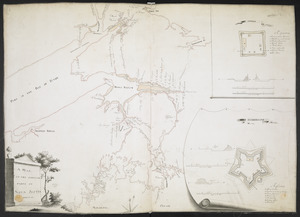A DRAUGHT of the ISTHMUS which joyns Nova Scotia to the Continent with the Situation of the ENGLISH and FRENCH FORTS & the Adjacent BAYS and RIVERS
This map is also available in American Revolutionary Geographies Online (ARGO), a collections portal especially built for material relating to the American Revolutionary War Era. Visit ARGO to learn more about this item and explore the historical geography of North America in the late eighteenth century.
Item Information
- Title:
- A DRAUGHT of the ISTHMUS which joyns Nova Scotia to the Continent with the Situation of the ENGLISH and FRENCH FORTS & the Adjacent BAYS and RIVERS
- Description:
-
A detailed manuscript map by Winckworth Tonge with its focus on the English Fort Lawrence and the French Fort Beauséjour, drawn in the months just prior to the Battle of Beauséjour.
- Cartographer:
- Tonge, Winckworth, 1727 or 1728-1792
- Former owner:
- George, III, King of Great Britain, 1738-1820
- Donor:
- George, IV, King of Great Britain, 1762-1830
- Name on Item:
-
by W Tonge Chignecto Fort Lawrence 1755.
- Date:
-
1755
- Format:
-
Maps/Atlases
Manuscripts
- Location:
- British Library
- Collection (local):
-
British Library Collection
- Subjects:
-
Acadians--Nova Scotia--History--Expulsion, 1755--Maps, Manuscript--Early works to 1800
Fort Cumberland (N.B.)--Maps, Manuscript--Early works to 1800
Chignecto Isthmus (N.B and N.S.)--Maps, Manuscript--Early works to 1800
- Places:
-
CanadaFort Beauséjour National Historic Park (historical park)
Chignecto Isthmus
- Extent:
- 1 map : manuscript with pen and ink and watercolour ; 53 x 74 cm
- Terms of Use:
-
No known copyright restrictions.
This work is licensed for use under a Creative Commons Attribution Non-Commercial Share Alike License (CC BY-NC-SA).

- Scale:
-
Scale 1:79,200
- Catalog Record:
-
http://explore.bl.uk/BLVU1:LSCOP-ALL:BLL01004987887
- Notes:
-
The title appears in a decorative cartouche at lower right illustrating native flora and fauna, including a beaver, and depicting friendly relations between the indigenous and colonial inhabitants by means of a handshake (contrary to the ongoing Acadian Exodus and the impending Great Upheaval, or Expulsion of the Acadians?). A British (?) vessel is visible in the distance.
The title cartouche also contains a "Scale of Miles" where 3/4 inch is equal to one mile.
The map includes "A View of the French Fort drawn from Fort Lawrence" at lower left.
A lettered "Explanation" (A-R) to the left of the page identifies rivers and includes the "Place where the English Man of War lyes", the route by which "the Vesells by that brings Provisions & Stores to the English Fort" and the "Dykes levelled by the English from which the Indeans used to Fire at the Vesells as they came up the River Mesiguash". They key also identifies the "French Fort at the Bay Vert" (Fort Gaspareaux) and "Pom a Buot a Small post possessed by the French".
The French fort, although not named, is Fort Beauséjour (later Fort Cumberland), dating the map prior to the Battle of Beauséjour in June 1755.
Short textual annotations on the map describe carrying places on the "River Chignecto" and highlight the "Villages burned by the Indeans" (during Father Le Loutre's War) - these villages are coloured red, while other settlements are shown in yellow.
The roads to Cobiquid and Bay Vert are delineated.
A decorative compass rose in the Bay of Fundy orients north on the page.






